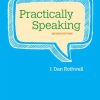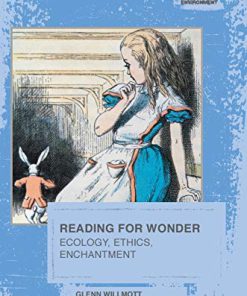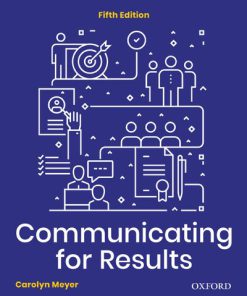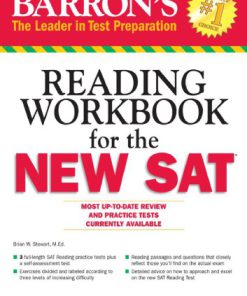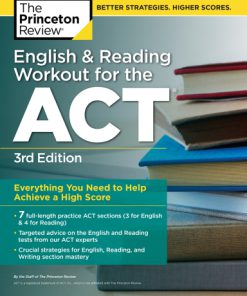Reading for Results 13th Edition by Laraine Flemming ISBN 1305500520 9798214351780
$50.00 Original price was: $50.00.$25.00Current price is: $25.00.
Reading for Results 13th Edition by Laraine Flemming – Ebook PDF Instant Download/Delivery: 1305500520, 9798214351780
Full download Reading for Results 13th Edition after payment

Product details:
ISBN 10: 1305500520
ISBN 13: 9798214351780
Author: Laraine Flemming
Compelling readings. Innovative writing assignments. Research-based explanations and exercises. READING FOR RESULTS, 13th Edition, includes all the trademark features you’ve come to expect from this leader in developmental reading instruction. Known for her ability to turn abstract reading theory into concrete reading practice, Laraine Flemming is back with a host of new explanations, exercises, and assignments that show students how to read and respond to textbook reading. This edition features brand new pointers on screen reading, numerous new writing assignments, expanded instruction on interpreting visual aids, more emphasis on a multi-sensory approach to learning, increased focus on evaluating web information, and much more.
Reading for Results 13th Table of contents:
1. Strategies for Learning from Textbooks
Introducing SQ3R: Survey, Question, Read, Recall, Review
S: Survey to Get a General Overview and Make Predictions
Don’t Skip Those Visual Aids
Q: Ask and Answer Questions While Reading
R1: Read in Sections or Chunks
R2: Recall Right After Reading
R3: Review Right After Completing the Assignment
Writing and Reading
Putting the Spotlight on Paraphrasing
Paraphrase to Check Comprehension
Paraphrase to Remember
Pointers on Paraphrasing for Reading
Be Selective
Use Language that is Equally General or Equally Specific
Accept the Fact that Some Words Don’t Translate
Feel Free to Change the Order of Ideas
Look Away from the Text when you Paraphrase
Don’t Confuse Paraphrasing for Reading Notes with Paraphrasing for Term Papers
Mining the Web for Background Knowledge
The Web Makes a Difference
Build Background Knowledge Before Reading
Your Timing Matters
Be a Savvy Searcher
Evaluating Websites
Screen Reading
Digging Deeper
Test 1. Reviewing Key Concepts
Test 2. Understanding Bar Graphs
Test 3. Paraphrasing
2. Building Word Power
Making the Meanings “Automatic”
Active Reviews and Memory Pegs
Using Context Clues
Developing Approximate Definitions
Example Clues
Contrast Clues
Restatement Clues
Mobilize Your Vocabulary Reviews
General Knowledge Clues
Context and Meaning
Defining Words from Their Parts
Learning Roots, Prefixes, and Suffixes
Combine Forces: Use Context Clues and Word Parts
Learn Word History to Expand Your Vocabulary
Connotations and Denotations of Words
Matching Up Connotation with Context
Changing the Connotation with the Context
Looking Up Words While You Read
Looking Up Words Online
Use a Print Dictionary for Writing
A Note on Dictionaries and Writing
Getting Down the Basics: Syllable Count, Pronunciation Guide, and Parts of Speech
Sorting Through Multiple Meanings
Figurative and Literal Word Meanings
Evaluating Websites About Words
Digging Deeper
Test 1. Reviewing Key Concepts
Test 2. Using Context Clues
Test 3. Using Context Clues
Test 4. Using Context Clues
Test 5. Using Word Analysis and Context Clues
Test 6. Using Word Analysis and Context Clues
Test 7. Using Word Analysis and Context Clues
3. Looking for Specific Topics and General Main Ideas
Starting with General and Specific Words
Identifying the Author’s Specific Topic
Phrasing the Topic
Following the Topic References
Constructing the Topic with the Author
Moving on to General and Specific Sentences
Recognizing Different Levels of General and Specific Sentences
Why Recognizing Shifts in Level Is Important
Three Common General and Specific Patterns in Paragraphs
Explanatory Pattern 1: Starting Off with the Topic Sentence
Explanatory Pattern 2: Starting with an Introductory Sentences and a Reversal Transition
Explanatory Pattern 3: Ending with the Topic Sentence
Digging Deeper
Test 1. Reviewing Key Concepts
Test 2. Recognizing the Most General Sentence
Test 3. Clarifying General Sentences
Test 4. Locating Topic Sentences
4. Getting to the Point of Paragraphs
Additional Ways Authors Introduce Topic Sentences
“That was Then, This is Now” Introduction
Line Graphs Illustrating “Then and Now”
When Lines on a Graph Double Up
Moving Toward the Middle
Doubling Up on Topic Sentences
Introductory Questions Can Replace Introductory Sentences
The Answers Don’t Always Arrive Right After the Question
Working with the Writer to Construct the Topic and Main Idea
Tracking Repetition and Reference to Identify the Topic
Topics Are Implicit as Well as Explicit
From Topic to Main Idea via Repetition and Reference
Different Texts Require Different Approaches
Digging Deeper
Test 1. Reviewing Key Concepts
Test 2. Identifying Topics and Main Ideas
Test 3. Constructing Main Ideas and Recognizing Topic Sentences
5. Getting to the Point of Longer Readings
Pattern 1: Opening with the Main Idea
Supporting Details: Connecting the Familiar to the New
Pattern 2: Ending with the Main Idea
Pattern 3: Using Reversal Transitions to Introduce Thesis Statements
Pattern 4: Answering a Question with the Thesis Statement
Digging Deeper
Test 1. Reviewing Key Concepts
Test 2. Recognizing Thesis Statements
Test 3. Recognizing and Paraphrasing Thesis Statements
Test 4. Recognizing and Paraphrasing Thesis Statements
Test 5. Recognizing and Paraphrasing Thesis Statements
6. Focusing on Supporting Details in Paragraphs
The Function of Supporting Details
Supporting Details and Main Ideas
Topic Sentences Can’t Do It All
Major and Minor Supporting Details
Evaluating the Contribution of Minor Details
When Minor Details Double Up, the Reader Needs to Think Twice
Category Words in Topic Sentences Signal Major Details
Using Category Words to Keep Readers on Track
Outside the Topic Sentence, Category Words Can Turn into Transitions
Addition Transitions Are Clues to Major Details
When Addition Transitions Are Used More Sparingly
Concluding Sentences Versus Supporting Details
Concluding Sentences Look Ahead to the Next Paragraph
Digging Deeper
Test 1. Reviewing Key Concepts
Test 2. Recognizing Supporting Details
Test 3. Identifying Topic Sentences and Supporting Details
Test 4. Distinguishing Between Major and Minor Details
Test 5. Using Category Words as Clues to Major Details
Test 6. Recognizing Supporting Details and Concluding Sentences
7. Focusing on Supporting Details in Longer Readings
Responding to Supporting Details in Longer Readings
Thesis Statement Locations
When It Comes to Reading, There Are No Rigid Rules
Thesis Statements Can Turn Up in Unexpected Places
Major and Minor Details Revisited
The Value of Visuals Aids in Longer Readings
On Reading Pie Charts
Outlining (Informally) Multi-Paragraph Readings
Making an Informal Outline
Digging Deeper
Test 1. Reviewing Key Concepts
Test 2. Recognizing Thesis Statements and Supporting Details in Longer Readings
Test 3. Recognizing Thesis Statements and Supporting Details in Longer Readings
8. Focusing on Inferences in Paragraphs
How Inferences Work
Evaluating Inferences
When Inferences Go Astray
Connecting Topic Sentence Pronouns to Their Antecedents
Connecting Pronouns and Antecedents in Topic Sentences
Piecing Together Main Idea Statements
Recognizing the Role of Bridging Inferences
Inferring the Main Idea from Start to Finish
When Should You Think About Inferring the Main Idea?
Making a Logical Inference
Reviewing Logical and Illogical Inferences
Inferring Supporting Details
Inferring the Meanings Appropriate to the Context
Inferring Relationships and Adding Information
Digging Deeper
Test 1. Reviewing Key Concepts
Test 2. Linking Pronouns to Antecedents in Topic Sentences
Test 3. Constructing Main Idea Statements
Test 4. Recognizing the Implied Main Idea
Test 5. Recognizing the Implied Main Idea
Test 6. Inferring the Implied Main Idea
Test 7. Inferring the Implied Main Idea
9. Understanding the Role of Inferences in Longer Readings
Implied Main Ideas Can Sum Up Longer Readings
Drawing the Logical Inference
Checking Your Inference Against the Author’s Words
Drawing Inferences to Connect Paragraphs
Focusing on Paragraph Openings
Writing Summaries
Summarizing: Paraphrasing with a Difference
Summarizing Longer Readings
If the Purpose Changes, So Can the Details
Digging Deeper
Test 1. Reviewing Key Concepts
Test 2. Recognizing the Implied Main Idea
Test 3. Inferring the Implied Main Idea
Test 4. Inferring Connections Between Sentences and Paragraphs
Test 5. Writing a Summary
10. Learning from Organizational Patterns in Paragraphs
It’s the Thought That Counts
Pattern 1: Definition
Pattern Variations
Pattern 2: Time Order
Time Order: Process
Time Order: Sequence of Dates and Events
Pattern 3: Simple Listing
Typical Topic Sentences
Pattern 4: Comparison and Contrast
Transitional Signals
Pattern 5: Cause and Effect
Cycles of Causes and Effects
Pattern 6: Classification
Typical Topic Sentences
Making Classification Charts
Identifying the Primary Pattern
Digging Deeper
Test 1. Reviewing Key Concepts
Test 2. Recognizing Primary Patterns
Test 3. Recognizing Primary Patterns
Test 4. Recognizing Primary Patterns
11. Combining Patterns in Paragraphs and Longer Readings
Combining Patterns in Paragraphs
Taking Notes on Mixed Pattern Paragraphs
Not All Patterns Are Equal
From Pure to Mixed Patterns in Longer Readings
When Patterns Combine in Longer Readings
Evaluating the Organizational Patterns
Taking Notes on Combined Patterns
Evaluating the Patterns
Inferring the Main Idea
Sifting and Sorting Pattern Elements
Digging Deeper
Test 1. Reviewing Key Concepts
Test 2. Identifying Main Ideas and Patterns of Organization
Test 3. Identifying Main Ideas and Patterns of Organization
12. Responding to Persuasive Writing
Recognizing the Primary Purpose
Facts and Opinions Are Clues to Purpose
Facts
Opinions
Combining Opinions with Facts
Recognizing When Persuasion Is Primary
The Title Often Takes Sides
The Author Takes a Stand
The Supporting Details Provide the Evidence
Choosing a Tone
In Persuasive Writing, Both Sides Rarely Get Equal Time
Sound Arguments Need Sound Reasoning
Recognizing Shaky Support
Hasty Generalizations
Irrelevant Evidence
Circular Reasoning
Offering False Alternatives
Making Careless Comparisons
Turning the Tables: From Reader to Writer
Taking a Stand
Diagramming Your Thoughts Instead of the Writer’s
Diagram, Draft, Revise, and Diagram Again
Digging Deeper
Test 1. Reviewing Key Concepts
Test 2. Identifying Fact, Opinion, or Both
Test 3. Identifying Tone
Test 4. Getting to the Point
Test 5. Identifying the Author’s Point, Purpose, and Tone
Test 6. Locating Errors in Logic
People also search for Reading for Results 13th:
Tags:
Laraine Flemming,Reading,Results
You may also like…
Politics & Philosophy
Popular Struggle and Democracy in Scandinavia: 1700-Present 1st Edition Flemming Mikkelsen
Housekeeping & Leisure - Interior Design & Decoration
Travel Home Design with a Global Spirit 1st Edition Caitlin Flemming
Politics & Philosophy - Philosophical Positions & Movements
Reading for Wonder Ecology Ethics Enchantment 1st Edition Willmott
Uncategorized
Education Studies & Teaching - Education - General & Miscellaneous
Education Studies & Teaching - School Education & Teaching
Languages - Korean Language Reference
Easy Korean Reading For Beginners 1st Edition by Talk To Me In Korean ISBN 1087891133 9781087891133



